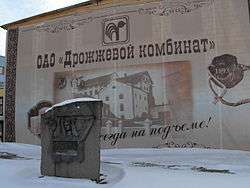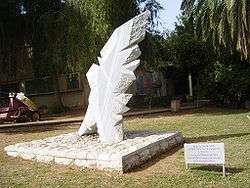Masha Bruskina
Maria "Masha" Bruskina (Belarusian: Марыя Барысаўна Брускіна Marïya Barïsawna Bruskina; Russian: Мария Борисовна Брускина Mariya Borisovna Bruskina; 1924 – 26 October 1941 in Minsk[1]) was a Belarusian Jewish nurse and member of the Minsk Resistance during World War II.[2] While volunteering as a nurse, she cared for Soviet forces, and assisted them escaping. For this she was executed by German forces.
_(crop).jpg)

Biography
Masha Bruskina lived in Minsk with her mother, senior goods manager of the Book Trade Office of the BSSR State Publishing House. She studied well and read a lot. She was also a pioneer leader and a member of the school committee of Komsomol. in December 1938, the newspaper Pioneer of Belarus published a photograph of Masha with the caption: "Masha Bruskina - the schoolgirl of 8th grade in school № 28, Minsk. She has only good and excellent marks in all subjects". In June 1941, Maria Bruskina graduated from Minsk secondary school № 28.
The execution
She volunteered as a nurse at the hospital in the Minsk Polytechnic Institute, which had been set up to care for wounded members of the Red Army. In addition to caring for the soldiers, she helped them escape by smuggling civilian clothing and false identity papers into the hospital. A patient told the Germans what Bruskina was doing, and she was arrested on October 14, 1941, by members of the Wehrmacht's 707th Infantry Division and the 2nd Schutzmannschaft Battalion,[3] Lithuanian auxiliary troops under the command of Major Antanas Impulevičius.
After being arrested, Bruskina wrote a letter to her mother on October 20, 1941:
I am tormented by the thought that I have caused you great worry. Don't worry. Nothing bad has happened to me. I swear to you that you will have no further unpleasantness because of me. If you can, please send me my dress, my green blouse, and white socks. I want to be dressed decently when I leave here.
Local German authorities decided on a public hanging to make an example of Bruskina, along with two other members of the resistance, 16-year-old Volodia Shcherbatsevich and World War I veteran Kiril Trus. Before being hanged, she was paraded through the streets with a placard around her neck which read, in both German and Russian: "We are partisans and have shot at German troops". Members of the resistance were made to wear similar signs whether or not they had actually shot at German troops. She and her two comrades were hanged in public on Sunday, October 26, 1941, in front of Minsk Kristall, a yeast brewery and distillery plant on Nizhne-Lyahovskaya Street (15 Oktyabrskaya Street today). The Germans let the bodies hang for three days before allowing them to be cut down and buried.[4]
A witness of the execution said:
When they put her on the stool, the girl turned her face toward the fence. The executioners wanted her to stand with her face to the crowd, but she turned away and that was that. No matter how much they pushed her and tried to turn her, she remained standing with her back to the crowd. Only then did they kick away the stool from under her. Pyotr Pavlovich Borisenko
Olga Shcherbatsevich, the mother of Volodia Shcherbatsevich, was hanged the same day as her son with two other members of the resistance in front of the National Academy of Sciences of Belarus.[5]
Identification and remembrance
For decades after the war, Bruskina was officially referred to only as "the unknown girl", allegedly due to antisemitism from Soviet authorities.[6] Up to 2009, Bruskina's name was not acknowledged on the memorial plaque at the execution place. However, since 2009, a new memorial plaque at the execution place has been placed. The Russian inscription now reads "Here on October 26, 1941 the Fascists executed the Soviet patriots K. I. Truss, V. I. Sherbateyvich and M. B. Bruskina". Bruskina was first recognized in the 1960s, as most of her family and friends had been killed in the Minsk Ghetto.[7] A monument for Bruskina was erected in HaKfar HaYarok in Israel, and a street was named after her in Jerusalem.
 Commemorative at the entrance of Minsk yeast plant, at the place of execution K.I. Trus, V. I. Scherbachevich and M. B. Bruskina.
Commemorative at the entrance of Minsk yeast plant, at the place of execution K.I. Trus, V. I. Scherbachevich and M. B. Bruskina. Monument in memory of M. Bruskina and other Jewish women, who fought against the Nazis. Kfar Ha-Yarok, Israel.
Monument in memory of M. Bruskina and other Jewish women, who fought against the Nazis. Kfar Ha-Yarok, Israel.
References
- "Archived copy". Archived from the original on 2014-05-30. Retrieved 2014-05-30.CS1 maint: archived copy as title (link)
- "Archived copy". Archived from the original on 2016-09-08. Retrieved 2016-08-31.CS1 maint: archived copy as title (link)
- USA v KAZYS CIURINSKAS
- "Archived copy". Archived from the original on 2016-09-23. Retrieved 2016-08-31.CS1 maint: archived copy as title (link)
- A Historical Injustice: the case of Masha Bruskina; by Nechama Tec and Daniel Weiss, University of Connecticut in Stamford, Johns Hopkins University Holocaust and Genocide Studies; 1997 11(3):366-377; doi:10.1093/hgs/11.3.366
- Keller, Bill (Sep 16, 1987). "Did Soviets hide identity of executed teen in 1941?". The Palm Beach Post. pp. D1. Retrieved 30 May 2015.
- "Archived copy". Archived from the original on 2014-05-30. Retrieved 2014-05-30.CS1 maint: archived copy as title (link)
- Cholawski, Shalom. "Minsk", in Encyclopaedia of the Holocaust vol. 3, p. 975. Captioned photograph of Masza Bruskina's hanging.
External links
- The case of Masha Bruskina on YouTube, a lecture by Daniel Weiss
- The Harvest, a musical based on the life of Masha Bruskina
- Eyewitness accounts of her execution
- Nechama Tec and Daniel Weiss: "A Historical Injustice: The Case of Masha Bruskina". Holocaust and Genocide Studies 11:3 (1997), p. 366-377. Online abstract
- The new 2009 memorial plaque at the execution place
- The old memorial plaque at the execution place that was removed 2009.